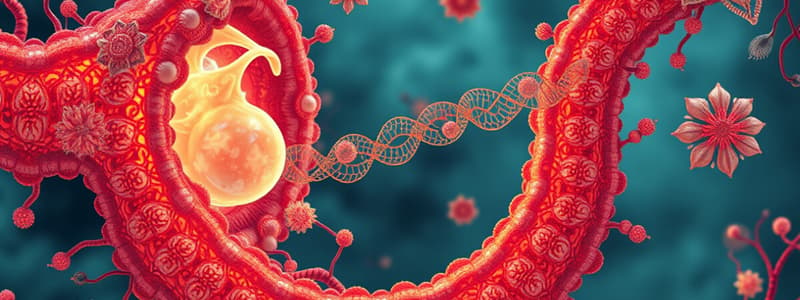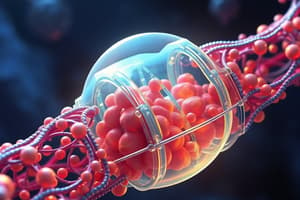Podcast
Questions and Answers
How is the cell membrane best described with respect to its functionality?
How is the cell membrane best described with respect to its functionality?
- Important
- Permeable (correct)
- Isolated
- Open
The transport of materials through the cell membrane is unimportant for cellular functions.
The transport of materials through the cell membrane is unimportant for cellular functions.
False (B)
What is the main difference between active and passive transport?
What is the main difference between active and passive transport?
Active transport requires energy, while passive transport does not.
Structure B represents a \\\\\\\\\_ and is used by the cell to move large particles through the cell membrane.
Structure B represents a \\\\\\\\\_ and is used by the cell to move large particles through the cell membrane.
What is the term for the difference in concentration as illustrated in diffusion?
What is the term for the difference in concentration as illustrated in diffusion?
Describe one similarity and one difference between a plastic bag and a cell membrane.
Describe one similarity and one difference between a plastic bag and a cell membrane.
Match each process of transport with its description:
Match each process of transport with its description:
The process used to relieve soreness in the throat by gargling is related to the absorption of water, and is often recommended because it creates a \\ environment in which swelling may be reduced.
The process used to relieve soreness in the throat by gargling is related to the absorption of water, and is often recommended because it creates a \\ environment in which swelling may be reduced.
Flashcards are hidden until you start studying
Study Notes
Cellular Transport Quiz Overview
- The cell membrane enables the exchange of matter and energy, defining it as a permeable system.
- Observations regarding permeability can highlight the selective nature of membranes concerning material movement.
- The plastic bag resembles a cell membrane by allowing selective substance passage but differs as it is not semi-permeable; it lacks specific transport mechanisms.
Importance of Transport
- Transport through the cell membrane is crucial for maintaining homeostasis, supplying necessary nutrients, and removing waste.
- The primary distinction between active and passive transport lies in energy utilization; active transport requires energy input, while passive transport relies on concentration gradients.
Transport Mechanisms
- Structure B refers to a vesicle, facilitating the transport of large particles across the cell membrane. If particles move from high to low concentration, this process is termed passive transport.
- The difference in concentration represented in diagrams is known as a concentration gradient.
Factors Influencing Diffusion
- The rate of diffusion can be influenced by temperature (higher temperatures increase kinetic energy) and concentration difference (greater gradients accelerate diffusion).
- An example of diffusion in the human body includes the exchange of oxygen and carbon dioxide in alveoli during respiration.
Practical Applications
- The scientific adjective describing syrup compared to the egg's solute concentration is hypertonic.
- When placed in syrup, the egg experiences osmosis, causing it to lose water and potentially shrink due to the higher solute concentration outside.
- Observations from the egg osmosis experiment relate to why gargling with salt water can alleviate throat swelling—it draws excess fluid out of swollen tissues, reducing discomfort.
Cellular Organelles
- Golgi bodies are essential organelles that package cellular substances within vesicles for secretion, playing a key role in cellular transport dynamics.
Studying That Suits You
Use AI to generate personalized quizzes and flashcards to suit your learning preferences.




